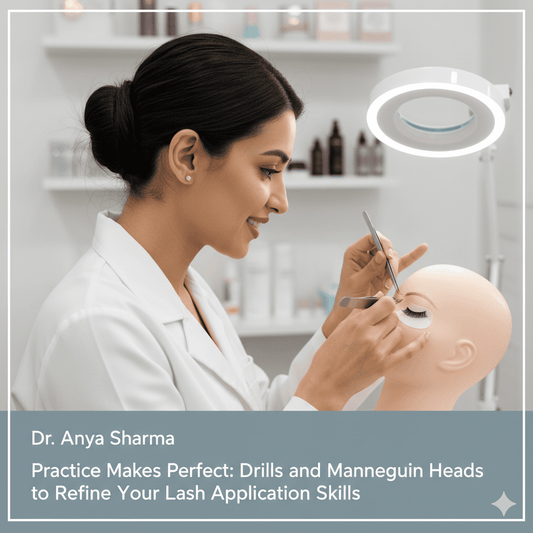Still struggling with isolation or placement? Targeted practice transforms beginners into confident professionals faster than client experience alone [5][6].
High-quality mannequin heads with realistic features enable repeated practice of isolation, placement, and adhesive control without client pressure [1][2][3].

After training hundreds of lash technicians, I've identified these essential practice methods that build muscle memory and precision.
1. Choosing the Right Practice Head
Using subpar training tools? Quality directly impacts skill development.
Select heads with close-to-skin realism, adjustable stands, and proper eyelid contours that mimic human anatomy [1][3][4].
Key Features to Prioritize:
| Feature | Training Benefit |
|---|---|
| Life-size proportions | Realistic working angles |
| Adjustable stands | Ergonomic positioning |
| Replaceable lashes | Cost-effective reuse |
Investing in professional-grade heads accelerates progress [1][3].
2. Foundational Isolation Drills
Skipping basic exercises? Master isolation before full sets.
Practice separating individual lashes using different isolation tools (tweezers, tapes) until you can consistently isolate within 3 seconds [5][8].
Isolation Practice Routine: - Work section by section (outer/inner corners) - Alternate isolation methods - Use timers to track speed - Mark problem areas with erasable pen - Repeat until muscle memory develops Daily 15-minute drills yield dramatic improvements [5][8].
3. Precision Application Exercises
Rushing extensions? Slow precision builds lasting speed.
Set micro-goals: perfect 10 lashes perfectly placed before increasing speed, focusing on consistent dip amounts and directional placement [7][9].

Progression Exercises:
| Stage 1 | Single extensions | 5/minute pace |
| Stage 2 | Alternating lengths | 8/minute pace |
| Stage 3 | Full mapping | Professional speed |
Document growth with photo comparisons [7][9].
4. Post-Training Practice Plans
Finishing certification unprepared? Structured homework bridges training and clients.
Complete 50+ hours on mannequins after certification, alternating between working on heads and live models under supervision [5][10].
Recommended Practice Structure: - Week 1-2: Focus solely on mannequins - Week 3-4: Alternate mannequin/live model - Week 5+: Gradually increase live models - Maintain 20% mannequin practice Build confidence progressively [5][10].
Conclusion
Consistent mannequin practice transforms theoretical knowledge into polished execution - dedicate daily practice time to perfect your craft [6][7].






